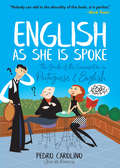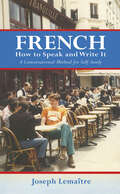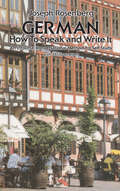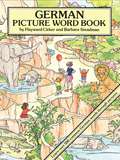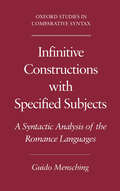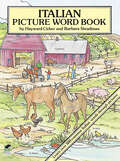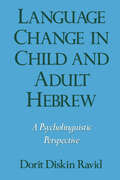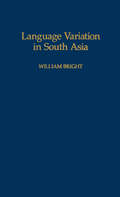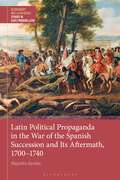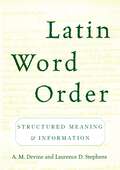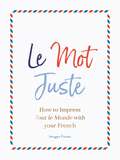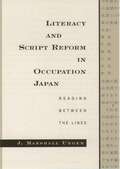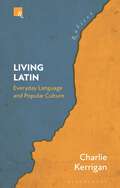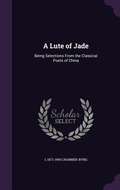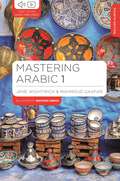- Table View
- List View
English as She Is Spoke: The Guide of the Conversation in Portuguese and English
by Mark Twain Pedro CarolinoThe Guide of the Conversation in Portuguese and English
Federico García Lorca, Selected Suites (Aris & Phillips Hispanic Classics)
by Roberta Ann QuanceThis volume offers a fresh translation of a generous selection of Lorca’s suites, a body of work that Federico García Lorca left largely unpublished upon his death in 1936. Composed between 1920 to 1923, these poems are closest in spirit and technique to Lorca’s Songs (1927) and his Poem of the Deep Song (1931). In 1926 the poet suggested they could be released together to form a ‘boxed set’, yet this plan, like other earlier efforts, fell through. Lorca’s suites reveal a poet who is interested in creating a modern style founded on popular oral lyric and fragmented narrative. But they also show a poet who explores his heart and his sexual orientation, and who may have hesitated too long about publication. Lorca achieved the fullest expression of a personal yearning in his long poem In the Garden of the Lunar Grapefruits. Out of an impossible contradiction between self-discovery and wariness of disclosure rises the blue world of the ideal—a timeless world that all readers of Lorca will want to take into account, inasmuch as it forms a counterpoint to the rest of his work.
French: How to Speak and Write It (Dover Language Guides French)
by Joseph LemaîtreProbably the most delightful, useful, and comprehensive elementary book available for learning spoken and written French, either with or without a teacher. Working on the principle that a person learns more quickly by example then by rule, Lemaître has assembled colloquial French conversations on a variety of subjects, as well as grammar, vocabulary, and idiom studies. Index.
German: How to Speak and Write It
by Joseph RosenbergThis is probably the most delightful, useful, and comprehensive elementary book available for learning spoken and written German, with or without a teacher. Working on the principles that a person learns more quickly by example than by rule, the author has put together a book that abounds in immediately usable German sentences and phrases on a wide variety of subjects.The student will find pleasure in the amusing sketches and drawings used to imbed new vocabulary firmly in the student's mind, in the many excellent photographs of cities and landmarks in German-speaking countries, and in the glimpses of German culture and custom subtly interwoven into the conventional material.The book, though eminently useful for self-study, is especially amenable to classroom use or study with a private tutor. The variety of teaching aids that this book places at the teacher's disposal is remarkable. The lessons contain dialogues, grammar and idiom studies (replete with examples), and extensive practice exercises. In addition there are 28 full-page and double-page sketches of specific scenes (a harbor, a zoo, a theatre, etc.) with pertinent items numbered and identified in German and English; sketches and photographs, which the student is asked to describe in German; German proverbs, jokes, and more.The dialogues and reading material encompass an exceptionally wide range of real-life situations, and are extended to include most of the basic vocabulary one would need in each situation. The analysis of German pronunciation is very comprehensive (and the simple phonetic system used in the early stages is readable by sight). The practice exercises are carefully designed to allow the student to use what he learned. The closing sections contain a summary of grammar, a guide to letter writing (with sample German letters), and a valuable study guide to German literature by Dr. Richard Friedenthal.The book differs from others of its type in that it gives more attention to the elementary stages of learning, and the rate of progress is less rapid than usual. This means that any intelligent person, even if he is an absolute beginner, can with sufficient application arrive at the end of the course confident of having acquired a solid foundation for further study.
German Picture Word Book
by Barbara Steadman Hayward CirkerHere's a pleasant and effective way for students of German to build and strengthen vocabulary skills. The book consists of 15 carefully rendered scenes -- 14 double-page and one single-page -- each devoted to a different theme of topic: Im Zoo (At the Zoo); Das Wohnzimmer (Living Room); Auf dern Bauernhof (On the Farm); Das Badezimmer (Bathroom); Das Schlafzimmer des Mädchens (Girl's Bedroom); Beim Abendessen (At Dinner); Das Schlafzimmer des Jungens (Boy's Bedroom); Der Supermarkt (Supermarket); Das Klassenzimmer (Classroom); Am Strand (At the Beach); and 5 more.Each illustration contains dozens of common objects, clearly labeled in German. By studying the illustrations, students can learn over 500 words for common household items, clothing, foods, vehicles, furniture, names of animals, parts of the body, types of stores and public buildings, and many more.To help reinforce words and meanings, all the scenes in this book are ideal for coloring. In addition, a complete list of German words (with definite articles) and English translations will be found at the back of the book. The result is an attractive and useful language resource that will appeal to any student of basic German, child or adult.
Hidden Texts, Hidden Nation: (Re)Discoveries of Wales in Travel Writing in French and German (1780-2018)
by Kathryn N Jones Carol Tully Heather WilliamsThis book explores the representation of Wales and ‘Welshness’ in texts by French- (including Breton) and German-speaking travellers from 1780 to the present day. Since the emergence of the travel narrative as a popular source of information and entertainment in the mid-18th century, writing about Wales has often been embedded and hidden in accounts of travel to ‘England’. This book locates and presents these largely forgotten texts and broadens perspectives to encompass European perceptions. Works uncovered for the first time include travelogues, private correspondences, travel diaries, articles and blogs which have Wales or Welsh culture as their focus. The ‘travellers’ analysed in this volume include those travelling for the purpose of leisure, scholarship or commerce as well as exiles and refugees. By focusing on Wales, a minoritized nation at the geographical periphery of Europe, the authors are able to problematize notions of hegemony and identity, relating to both the places encountered (the ‘travellee’ culture) and the places of origin (the travellers’ cultures). This book thereby makes an original contribution to studies in travel writing and provides an important case study of a culture often minoritized in the field, but that nevertheless provides a telling illustration of the dynamics of intercultural relations and representation.
Infinitive Constructions With Specified Subjects: A Syntactic Analysis Of The Romance Languages
by Guido MenschingItalian Picture Word Book
by Barbara Steadman Hayward CirkerHere’s a pleasant and effective way for students of Italian to build and strengthen vocabulary skills. The book consists of 15 carefully rendered scenes (14 double-page and one single-page), each devoted to a different theme or topic.Lo zoo: At the zooLa fattoria: On the farmLa camera di una ragazza: Girl’s bedroomLa camera di un ragazzo: Boy’s bedroomL’aula scolastica: ClassroomIl soggiorno: Living roomIl bagno: BathroomL’ora di pranzo: At dinnerIl supermercato: SupermarketLa spiaggia: At the beach… and five more.Each illustration contains dozens of common objects, clearly labeled in Italian. By studying the illustrations, students can learn over 500 words for common household items, clothing, foods, vehicles, furniture, names of animals, parts of the body, types of stores and public buildings, and much more.To help reinforce words and meanings, all the scenes in this book are ideal for coloring. In addition, a complete list of Italian words (with definite articles) and English translations will be found at the back of the book. The result is an attractive and useful language resource that will appeal to any student of basic Italian, child or adult.
Juvenal’s Tenth Satire
by Professor Paul MurgatroydThis is not a commentary on Juvenal Satire 10 but a critical appreciation of the poem which examines it on its own and in context and tries to make it come alive as a piece of literature, offering one man’s close reading of Satire 10 as poetry, and concerned with literary criticism rather than philological minutiae. In line with the recent broadening of insight into Juvenal’s writing this book often addresses the issues of distortion and problematizing and covers style, sound and diction as well. Much time is also devoted to intertextuality and to humour, wit and irony. Building on the work of scholars like Martyn, Jenkyns and Schmitz, who see in Juvenal a consistently skilful and sophisticated author, this is a whole book demonstrating a high level of expertise on Juvenal’s part sustained throughout; a long poem (rather than intermittent flashes). This investigation of 10 leads to the conclusion that Juvenal is an accomplished poet and provocative satirist, a writer with real focus, who makes every word count, and a final chapter exploring Satires 11 and 12 confirms that assessment. Translation of the Latin and explanation of references are included so that Classics students will find the book easier to use and it will also be accessible to scholars and students interested in satire outside of Classics departments.
Language Change In Child And Adult Hebrew: A Psycholinguistic Perspective
by Dorit Diskin RavidThe study of language acquisition has taken on new meaning in the last decade. Now seen as part of the study of other forms of language variation across time and space, such as dialects and sociolects, and the study of pidgins and Creoles, it can help to provide a new understanding of howlanguage evolves and what directs its development. Dorit Ravid here provides a study of contemporary speakers of Hebrew, focusing in particular on inflectional morphology. She traces language development from childhood to adulthood in Hebrew speakers, and explores strategies of language acquisitionand language processing leading to variation in the spoken Hebrew of speakers of different ages and socioeconomic backgrounds.
Latin Political Propaganda in the War of the Spanish Succession and Its Aftermath, 1700-1740 (Bloomsbury Neo-Latin Series: Studies in Early Modern Latin)
by Dr Alejandro CoroleuLatin Political Propaganda offers the first comprehensive study of the central role played by the Latin language to celebrate or undermine political power during the War of the Spanish Succession (1701-1715). Waged as much on the printed page as on the battlefield, this worldwide conflict gave rise to an astonishing variety of Latin writing across the Continent - in verse or in prose - on both the pro-Habsburg and pro-Bourbon sides. Ranging from official documents, epic, satirical and panegyric poetry to defamatory pamphlets, letters, historiographical and juridical tracts, medals and ephemeral architecture, this vast textual corpus has gone almost unnoticed. Alejandro Coroleu provides close examination of the literary devices of these texts and shows how imitation of models and figures from classical antiquity was at the heart of the authors' highly refined verse and prose technique. He also pays attention to the historical and social context in which the texts emerged, and connects the Latin political writing produced at the time with more popular forms of propagandistic discourse (literary or visual) which found its expression in the vernacular. This book also reveals how the learned language continued to function - even after the hostilities had come to an end in July 1715 - as an instrument of political discourse and propaganda on both sides of the dynastic feud up until the death of Emperor Charles VI in October 1740.
Le Mot Juste: How to Impress Tout le Monde with Your French
by Imogen Fortes'Charming, witty and cheerful, this is a delectable feast of the French language. Allez le Bleus!' Raymond BlancCelebrating the art of the French language with a charming collection of words and phrases to bring into everyday conversation. C’est parti!Have you ever wondered exactly what déjà vu is? Have you made a faux pas? Eaten an hors d’oeuvre? Voulez-vous an explanation of the above? Then voilà, here is a collection of les bons mots so you can start to learn that certain je ne sais quoi of the French language. Le Mot Juste contains 150 beautiful words and phrases that you’ll love to say every day.
Learning Greek with Plato: A Beginner's Course in Classical Greek (Bristol Phoenix Press Classical Handbooks)
by Frank BeethamAdult learners of ancient Greek are often attracted to it by the prospect of being able to read in the original a particular author or genre. Greek philosophical writing and Plato in particular is often the target. This book’s material has been tried and tested by the author over the years with adult classes, and can be used as a course textbook, or as a handbook for self-teaching.Each of 25 sections is clearly laid out – with tabulation of Greek word-forms and grammar. Each includes ample exercises and practice in reading Greek sentences. Readings in later sections consist of passages of continuous Greek from Plato’s Meno, a typical Platonic dramatic dialogue.
Living Latin: Everyday Language and Popular Culture (Rubicon)
by Dr Charlie KerriganWhat kind of language is Latin, and who is it for? Contrary to most accounts, this book tells the story of Latin as a language of ordinary people. Surveying the whole span of the language's history, it explores the evidence that exists for ordinary Latin around the Roman world, arguing that this material is just as worthy of readers' attention as the famous classics. Those classics are reassessed in the light of popular concerns, as works of art that evoke ancient, sustainable, and communal ways of living, encompassing broad and diverse traditions of readers through time. And of course Latin lived on: this account revisits what happened to the language after the Roman empire, tracing its twin streams - intellectual lingua franca and a series of Romance languages - into the twenty-first century. What emerges is a human chain stretching back thousands of years and still in existence today, a story of workers and weavers, violets and roses, storytellers and musicians, a common and democratic archive of world history. Kerrigan's strong and attractive case for a new conception of Latin sends out a call to arms to reevaluate the place of Latin in history. On the one hand, an interesting and readable history of the language, on the other, this book sets out to provoke questions for readers, students, and teachers of Latin, as well as anyone interested in the ancient Mediterranean world. Latin was and should always be for all.
Mastering Arabic 1 (Bloomsbury Master Series (Languages))
by Jane Wightwick Mahmoud GaafarLearn to understand, speak and read Modern Standard Arabic confidently with this lively and accessible text. Mastering Arabic 1 is aimed at beginners with little or no previous knowledge of the language. It gradually builds knowledge, introducing the Arabic script from the very first page. Mastering Arabic 1 is in full colour and features an abundance of cartoons, photos and engaging exercises. It also offers a wealth of audio and video resources, free-to-access online! Easily the bestselling Arabic course on the market, it is widely used in universities, schools, community colleges, adult evening classes and for self-study. New to this Edition:· Extended reading exercises that challenge students with longer passages, accompanied by exercises on the companion website. Links to newspapers and other Arabic material can also be found here. · Expanded video selection, now covering every language learning unit.· A refreshed design with updated photo programme.· Strengthened cross-referencing with the accompanying Grammar and Activity books.
